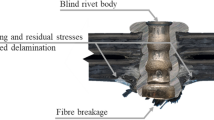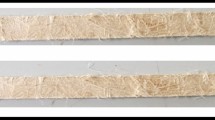Abstract
The role of rubber particle type, location and morphology on toughening in blends of nylon 6,6 with styrene acrylonitrile (SAN), with and without fibre reinforcements was examined in this study. The rubber used was ethylene propylene diene monomer (EPDM) rubber and the results were compared to a previous study that used butadiene rubber. The compositions of the blends ranged from pure nylon 6,6 to pure SAN. EPDM rubber was chemically compatibilized with one of the matrix phases rather than grafted, as in the ABS. In order to study the effect of rubber location on fracture behaviour, the approach was to compatibilize EPDM with either the minor phase or the major phase component of the blend. Attention was focused on fracture initiation toughness and fracture propagation toughness, measured through the parameters J IC and J SS, respectively. J SS refers to the steady-state, or plateau value of the material R-curve and was therefore a measure of total toughness which included the additional component derived from crack extension. The results indicated that EPDM rubber was not as effective a toughening agent as was butadiene in the Acrylonitrile Butadiene Styrene (ABS) system, primarily due to the morphology of EPDM and its interface character with the nylon 6,6 or SAN matrix. It was demonstrated that the embrittlement effects of a second rigid polymer phase can be mitigated by selectively adding rubber to that phase in the alloy or blend. With regard to the role of fibre reinforcement, a strong fibre matrix interface was found to be essential for toughening. Further, the extent of rubber toughening was larger when fibres were present than when fibres were absent, provided the fibre matrix interface was strong. Fibres also, like rubber, enhanced local matrix plasticity as well as reduced the embrittlement effects associated with a second polymer phase.
Similar content being viewed by others
References
S. V. NAIR, S. C. WONG and L. A. GOETTLER, J. Mater. Sci. 32 (1997) 5335–5341.
S. V. NAIR, A. SUBRAMANIAM and L. A. GOETTLER, J. Mater. Sci. 32 (1997) 5347–5354.
“A Testing Protocol for Conducting J-Crack Growth Resistance Curve Tests in Plastics” (1992), ASTM, Philadelphia, USA.
S. WU, Polymer 26 (1985) 1855.
S. V. NAIR, A. SUBRAMANIAM and L. A. GOETTLER, J. Mater. Sci., to be submitted.
Author information
Authors and Affiliations
Rights and permissions
About this article
Cite this article
Nair, S.V., Subramaniam, A. & Goettler, L.A. Fracture resistance of polyblends and polyblend matrix composites Part III Role of rubber type and location in nylon 6,6/SAN composites . Journal of Materials Science 33, 3455–3464 (1998). https://doi.org/10.1023/A:1013266204096
Issue Date:
DOI: https://doi.org/10.1023/A:1013266204096




